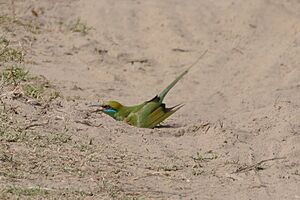Asian green bee-eater facts for kids
Quick facts for kids Asian green bee-eater |
|
|---|---|
 |
|
| M. o. ceylonicus, Sri Lanka | |
| Conservation status | |
| Scientific classification | |
| Synonyms | |
|
The Asian green bee-eater (Merops orientalis) is a beautiful bird from the bee-eater family. It's also known as the little green bee-eater. These birds live in many parts of Asia, from Iran all the way to Vietnam. You can often find them in grasslands, light forests, and bushy areas. They love to eat insects, especially bees!
Some bee-eaters that used to be considered the same species, like the African green bee-eater and the Arabian green bee-eater, are now seen as different species.
Contents
About the Asian Green Bee-Eater
The Asian green bee-eater was first described by a scientist named John Latham in 1801. Scientists have found different types, or subspecies, of this bird. These subspecies look a bit different depending on where they live:
- M. o. beludschicus: Found from Iran to Pakistan. These birds are paler and have a blue throat.
- M. o. orientalis: Lives in India and Sri Lanka. Their head and neck have a reddish-brown color.
- M. o. ferrugeiceps: Found in places like northeastern India, Myanmar, Thailand, and Vietnam. They have a reddish-brown crown and back.
- M. o. ceylonicus: Lives in Sri Lanka. This type has a more golden-brown shine on its neck.
In 2021, the IOC decided that the African green bee-eater and the Arabian green bee-eater are separate species. They used to be thought of as the same as the Asian green bee-eater.
What They Look Like
Asian green bee-eaters are colorful and slender birds. They are about 9 inches (23 cm) long. This includes their two long central tail feathers, which add about 2 inches (5 cm) to their length. Both male and female birds look the same.
Their feathers are bright green. Their chin and throat often have a blue tint. The top of their head and upper back can look golden-brown. Their wing feathers are reddish-brown with green and black tips. They have a thin black line that goes through their eyes. Their eyes are red, their beak is black, and their legs are dark gray. Young birds do not have the long tail feathers.
When they fly, you can often hear their call. It sounds like a nasal trill: tree-tree-tree-tree.
Where They Live
These birds are common and quite friendly. They live in open areas with bushes. In Africa and Arabia, they prefer dry places. But further east, they can be found in many different habitats.
Asian green bee-eaters often hunt from low perches. They might sit on a fence wire or an electric wire, sometimes only a meter off the ground. Unlike some other bee-eaters, they don't always need to be near water.
You usually see them in flat areas. However, they can sometimes be found high up in the Himalayas, around 5,000 to 6,000 feet (1,500 to 1,800 meters). In South Asia, they stay in the lowlands all year. Some groups move seasonally, perhaps to drier places in the rainy season or warmer spots in winter.
What They Do
Like other bee-eaters, these birds mainly eat insects. They especially love bees, wasps, and ants. They catch insects while flying from an open perch. Before eating, a bee-eater will hit the insect against its perch. This helps to remove stings and break the insect's hard shell.
These birds make seasonal movements, often based on rainfall. In the mornings, they can be a bit slow. You might see them huddled together on wires, sometimes with their beaks tucked into their backs. They often take dust baths, rolling around in the dirt. They also bathe in water by quickly dipping into it while flying.
Asian green bee-eaters usually live in small groups. They often gather in large numbers (200–300 birds) to sleep together. At these roosting spots, the birds get very excited and call loudly. They might fly off suddenly before settling back down in the roost tree.
These birds are also becoming common in cities and towns. You might see them sitting on TV antennas. They will quickly fly off in a zig-zag pattern to catch an insect. Then they return to the same spot to eat their meal. This often happens in the early morning or late afternoon.
The breeding season for these birds is from March to June. They often nest alone, digging a tunnel in a sandy bank. The tunnel can be as long as 5 feet (1.5 meters). At the end of the tunnel, they lay 3 to 5 eggs on the bare ground. The eggs are round and shiny white. Both parents take turns sitting on the eggs. The eggs hatch in about 14 days. The young birds leave the nest after 3 to 4 weeks.
They mostly eat flying insects. They will sometimes eat small crabs too. Like many birds, they spit out the hard parts of their prey as pellets.
Images for kids
-
M. o. orientalis eating a blue pansy butterfly







